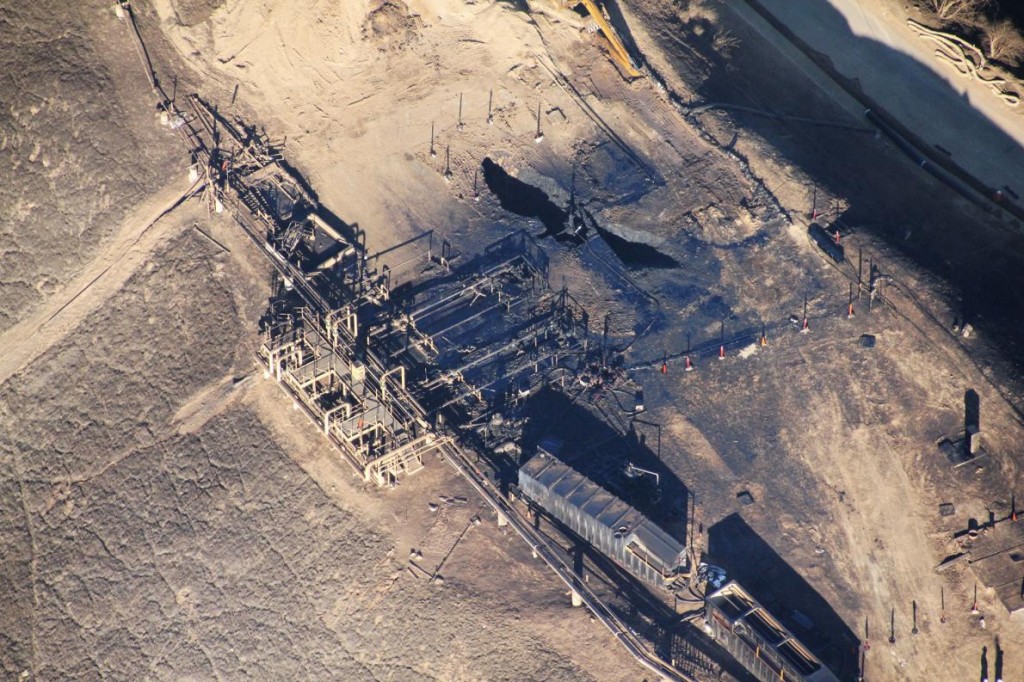Some associate the “natural” in natural gas with clean energy, but this is deceiving. There is nothing clean about gas. While it is produced from decomposing plant and animal matter, it is still a dirty fossil fuel. Gas is one of the leading causes of climate change and poses huge health and safety risks to our communities, especially working families and vulnerable communities including immigrants and refugees.

ALISO LEAK. SOURCE: PBS
Some of the biggest dangers of gas include:
“NATURAL GAS IS A BRIDGE TO NOWHERE.”
— Climate Reality Project [16]https://www.climaterealityproject.org/blog/3-big-myths-about-natural-gas-and-our-climate
Some think gas is the necessary bridge to renewable energy. However, gas is a bridge to nowhere. We do not need to depend on gas in order to retire coal and other fossil fuels. It’s possible to replace coal plants with renewables in the next decade. [17]https://www.yaleclimateconnections.org/2016/08/is-natural-gas-a-bridge-fuel A study by the Department of Energy’s National Renewable Energy Laboratory has proved that 80 percent of U.S. electricity needs can already be met by renewable technologies that are commercially available today. By investing public money in smarter ways and utilizing technology, a 100 percent clean and renewable energy future is achievable by 2045.
On the flip side, gas dependence could cripple efforts for a Just Transition by reducing investment in clean and renewable energy. This would leave ratepayers spending more money on diminishing resources that would not be used past 2045. Clean energy is the best and only viable investment to make in the long-term.
Some think the dangers of gas can be wiped away with carbon capture and storage (CCS), but this is not a silver bullet solution to the climate crisis. Not only have CCS projects largely failed in California despite millions of dollars in from ratepayers, [18]https://www.kqed.org/science/485125/despite-millions-in-investment-carbon-capture-flops-in-california but adding CCS to gas-fired plants would make building them much more expensive, and less suitable to frequent up and down ramping of their power output. [19]https://acee.princeton.edu/wp-content/uploads/2014/06/Andlinger-Energy-Tech-Distillate-Storage-Article-6.pdf
Even if CCS eventually succeeded and became less costly, this would not work for the removal of other pollutants released by gas. This means that vulnerable communities near gas wells and plants would still be affected by insurmountable air pollution.
We have proven technology today through clean energy resources. Let’s stop wasting our time on impractical solutions that don’t get us where the science tells us we need to be.
It is urgent that we get off all gas. Recently, the gas industry has used the phrase “renewable natural gas” to describe biogas that has been processed and refined into biomethane. They say biomethane is clean, but it is not. This is simply a distraction to stall efforts toward a clean energy future.
Biomethane may be renewable, but it is not necessarily clean. It often comes from polluting sources — landfills, sewage treatment plants, and livestock manure — that put communities in danger. [20]https://www.tandfonline.com/doi/full/10.1080/10934529.2018.1459076 The decomposition of manure, for instance, releases ammonia which leads to respiratory problems and higher risks of asthma. Fugitive methane emissions from biogas production and upgrading can also reduce the alleged benefits of biomethane. [21]https://www.sciencedirect.com/science/article/pii/B9780081010365000094 In addition, the production of biomethane relies on abundant supplies of waste manure or crop materials, which are not available in all regions. [22]https://www.power-technology.com/features/biogas-pros-and-cons
Biomethane, furthermore, would not reduce our dependence on gas because the fuel potential of biomethane is extremely limited. It would only meet 3 percent of California’s demand for natural gas. [23]https://www.ucsusa.org/sites/default/files/attach/2017/05/Promises-and-limits-of-Biomethane-factsheet.pdf
References